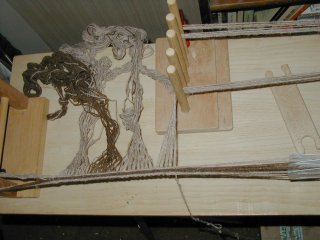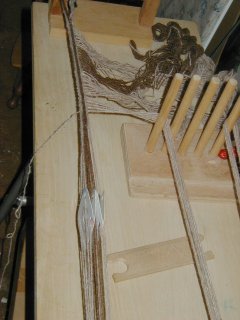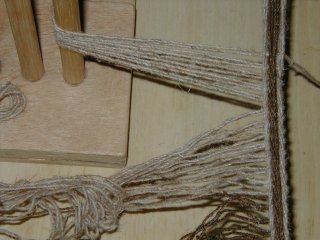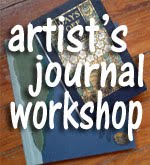Well, that got your attention, didn’t it?
Actually, I don’t think we will be having an orgy on Saturday at the Open Day at Silchester, where the Roman town of Calleva Atrebatum is being excavated, but I hope it will be fun anyway. As I mentioned last week, the Berkshire Guild will be demonstrating Roman weaving and spinning, or at least doing our best to do so. We will be weaving on a warp-weighted (WW) loom, tabletweaving (TW), and spinning using spindles based on whorls found on the site.
I hope to get a chance to spin there, but my main involvement is with the tablet weaving. I’ll be demonstrating TW on the day (using ‘authentic’ wooden cards if I can finish them in time, plastic ones if not), but I have also been weaving the starting band for the WW loom warp. [If you aren't interested in the more technical details, skip to the pictures near the end.]
Later, WW loom warps were made over a cord which was attached to the top beam, but in the Iron Age and Roman times they were made by weaving a narrow band with a long fringe on one side which formed the WW warp. This serves to space the warp threads, which the later simple starting cords do not.
When I had read about these bands before, I had assumed that they would be woven with an ordinary weft and that the WW warp would be a supplementarty weft, but reading the ‘bible’ on WW looms, by Martha Hoffman, I found that the WW warp is the only weft used. The band warp grips the weft (= WW warp) well enough to stay in place while the warp is mounted on the loom (at least for wool, I don’t know how well it would work with silk).
Some of these bands are plain weave, but the majority seem to have a twisted structure which suggestes that they were made by tabletweaving. Some could possibly have been made by manual warp twining, but there are some wider borders for which this would have been very unlikely. A tabletwoven starting border with tablets still attached has been found in Spain in a 5th century BC grave, so we know the method was defintely in use well before Romano-British times.
I’ve been collaborating with Elizabeth, a very skilled tapestry weaver who has taken primary responsibility for the weaving, Janet who is producing the weights, and her friend Ken who has built the loom for us. Unfortunately, I don’t have photos of the loom yet, but I will be taking lots of pictures at the event and hope to have them here by Sunday (if I’m not exhausted), and there will be pictures on the guild site too.
My task was to produce the warp for the loom. We didn’t want to use a fine warp as that would make it harder for visitors to see what we are doing, so we decided on a well-twisted 2-ply wool yarn that will weave balanced plain weave at 8 ends (threads) per inch. Because of space restrictions our loom will only weave cloth about 24″ wide, but for this first attempt, our warp will only be 15-16″ wide.
The WW warp ‘fringe’ needs to be about 6 foot long and as consistent as possible. It is created by pulling loops of thread through the TW band, so I needed some way of measuring the length of those loops without having to keep walking across the room. The pictures below give an idea of how I set it up – as usual, click for a larger version.
Here is a better picture of the band and ‘fringe’ in progress.
I found it much easier to weave the band than I had expected. The biggest problem is that using the same yarn for the band and the WW warp and beating in the usual way for tabletweaving gives a warp spacing that is too close for plain weave. We had already decided that we didn’t want to weave twill as that would require multiple heddle rods (if you have no idea what a heddle rod is, later posts here or on the guild site should have a proper explanantion of the construction of the loom). I found just pressing the weft into position with my fingers once I had turned to the next shed was enough to give the right warp spacing. If we decide to weave twill for the second Open Day (yeah we might be that crazy!), I’ll probably need to beat that band in the usual way.
The next stage of warping will be to attach the band to the top beam. Elizabeth and I are meeting to do that tomorrow evening, so I may have a report (and pictures) on Friday.





